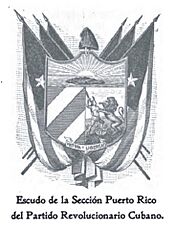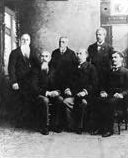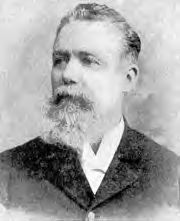Revolutionary Committee of Puerto Rico facts for kids
|
Comité Revolucionario de Puerto Rico
|
|
 |
|
| Abbreviation | CRPR |
|---|---|
| Merged into | Cuban Revolutionary Party in 1892 as an affiliate under the name Club Borinquen and in 1895 as a segment under the name Sección de Puerto Rico del Partido Revolucionario Cubano (Puerto Rico Section of the Cuban Revolutionary Party) |
| Formation | January 8, 1867 |
| Founder | Exiled Puerto Rican revolutionaries, including Segundo Ruiz Belvis, Ramón Emeterio Betances, and Juan Ríus Rivera |
| Founded at | New York City in 1867, 1892, and 1895 |
| Dissolved | December 23, 1898 |
| Type | Political organisation |
| Purpose | Puerto Rican Independence Cuban Independence Anti-imperialism |
The Revolutionary Committee of Puerto Rico (known as the CRPR) was a group formed by Puerto Ricans who wanted their island to be free from Spanish rule. It was started on January 8, 1867, in New York City. Important leaders like Segundo Ruiz Belvis, Ramón Emeterio Betances, and Juan Ríus Rivera were among its founders.
The main goal of the committee was to unite Puerto Ricans and Cubans in their fight for independence from Spain. At that time, Puerto Rico and Cuba were the last parts of Spain's large empire in the Americas. The committee worked hard to support these independence movements.
The committee helped organize two important revolts in Puerto Rico. These were the Grito de Lares in 1868 and the Intentona de Yauco in 1897. They also provided money and weapons to help Cuba's fight for freedom during the Ten Years' War.
In 1895, the committee officially joined the Cuban Revolutionary Party. Many of its members were living in New York City alongside Cuban heroes like José Martí. On December 22, 1895, the committee also approved the current design of the flag of Puerto Rico. This flag became the new symbol for a free "Republic of Puerto Rico."
The Grito de Lares Revolt
On September 23, 1868, the Revolutionary Committee, led by Betances, declared Puerto Rico's independence. This happened in the town of Lares, Puerto Rico. They called it the Republic of Puerto Rico.
About 400 to 600 rebels gathered and marched into Lares. They took over the city hall and some stores. By 2:00 AM, they officially announced the Republic of Puerto Rico. Francisco Ramírez Medina was named its president. However, Spanish soldiers quickly stopped the revolt. About 475 rebels were arrested. This event became known as the Grito de Lares, or the "Cry of Lares." Even though it failed, it was a very important moment in Puerto Rico's history.
The Committee in New York City
On December 22, 1895, the Puerto Rican Revolutionary Committee was re-established in New York City. It became a part of the Cuban Revolutionary Party. Many Puerto Ricans and Cubans who wanted independence lived in New York City.
On that same day, members of the committee met. They decided to change the flag that had been used during the Grito de Lares. They adopted a new flag, which was similar to the Cuban flag but with the colors inverted. This new flag became the symbol for a future "Republic of Puerto Rico." This flag is now the official flag of Puerto Rico, recognized by most people since 1895 and officially adopted in 1952.
Some of the important members present at this meeting included Juan de Mata Terreforte, Manuel Besosa, and Roberto H. Todd.
The Intentona de Yauco
In 1897, Antonio Mattei Lluberas visited the committee in New York City. He met with leaders like Betances and Terreforte to plan another big revolt. The plan was for Betances to lead it, and General Rius Rivera to command the fighters. Ríus Rivera was a leader in the Cuban fight for independence at the time.
Mattei Lluberas bought many machetes for the rebels. He returned to Puerto Rico with a new Puerto Rican flag and started preparing for the uprising. However, Spanish officials found out about their plans. Mattei Lluberas wanted to start the revolt right away, but other leaders worried it would fail like the Grito de Lares.
The committee in New York had also been trying to convince U.S. President William McKinley to invade Puerto Rico. After the U.S. took control of Cuba, President McKinley approved the invasion of Puerto Rico. U.S. ships sailed to Puerto Rico, and the island was taken over. Under the Treaty of Paris of 1898, signed on December 10, 1898, the United States officially took control of Puerto Rico.
See also
- El Grito de Lares
- Intentona de Yauco
- Puerto Rican independence movement
- Ramón Emeterio Betances
- List of Puerto Ricans
- List of Puerto Rican military personnel




